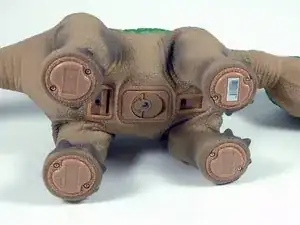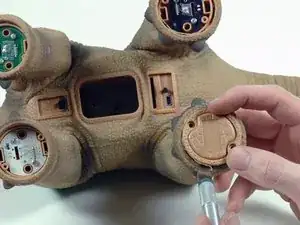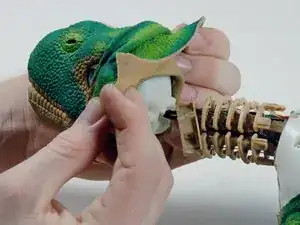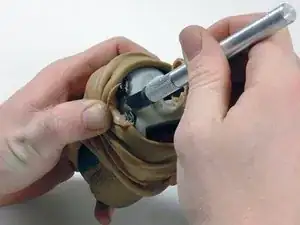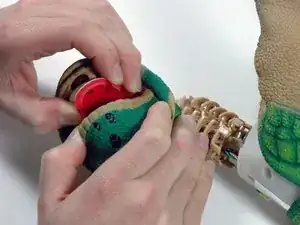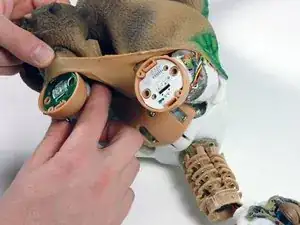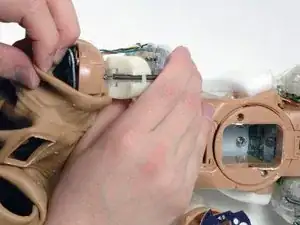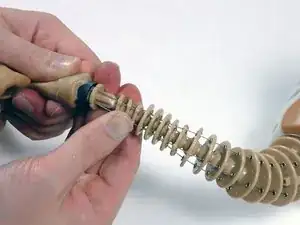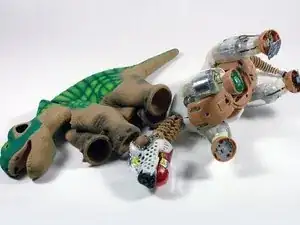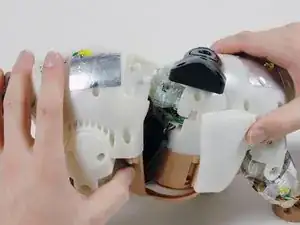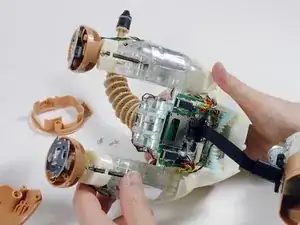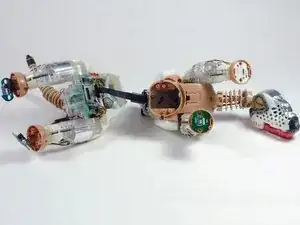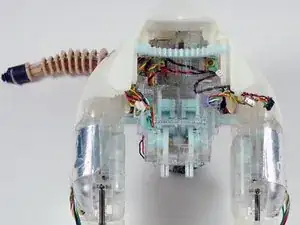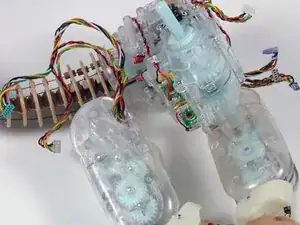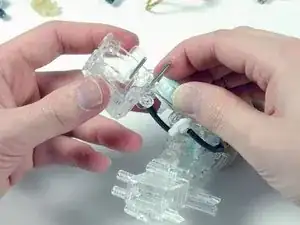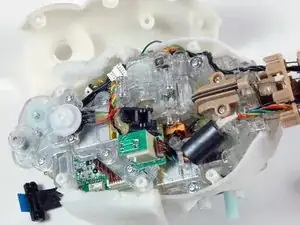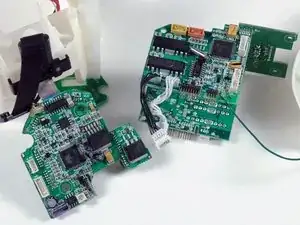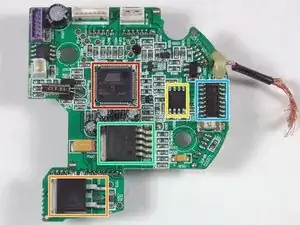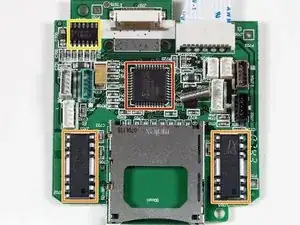Einleitung
We disassembled this dinosaur on January 14, 2008.
Werkzeuge
-
-
The obvious place to begin disassembling any organism is the belly. Pleo has two screws on each foot.
-
The battery compartment is in the middle, along with the the USB port and SD slot. There's also a debug port hidden underneath a cover next to the power switch.
-
Pleo came with a USB cable, but it's not clear what it's intended for. Ugobe's instructions for add-ons like their Holiday behavior require a SD card and reader.
-
-
-
Once we removed the feet, we cut the glue affixing the skin to the legs.
-
Pleo is quite the sophisticated creature. According to Howstuffworks, he has:
-
Two 32-bit ARM7 processors
-
Four 8-bit processors (ARM?) for motor control
-
Fourteen tiny motors
-
-
-
Removing the skin from the head. Ugobe used glue around each orifice to keep the skin secure, so this is trickiest part.
-
Pleo may be the most interactive toy ever made. He has:
-
One color camera
-
Two microphones
-
One IR transmitter
-
One accelerometer
-
Eight capacitance touch sensors
-
-
-
The color camera in his nose. Ugobe may have originally planned facial recognition, but currently Pleo can only use it to "get a feel of his surroundings."
-
He also sports binaural hearing with a microphone on each side of his head. The microprocessor compares the sounds received from each "ear" and allows him to work out the direction and distance of sound sources.
-
An infrared interrupter in his mouth lets him know if you have placed something in there. There is also an IR communicator which allows him to talk to other, like-minded dinosaurs.
-
-
-
Removing the skin from his legs and torso. The skin is elastic enough that the entire body section can be removed as one piece.
-
-
-
Stretching the skin around his rear legs.
-
Pleo's skin is loose over most of his body, but there are stiff plastic frames surrounding the ports and battery bay on his belly.
-
-
-
There is a dab of glue at the tip of the tail. The articulated tail is capable of a surprising variety of movement.
-
-
-
How to skin a dinosaur...
-
The eight capacitance sensors that allow Pleo to feel are located throughout his body: two on top of his torso, one under his chin, one on top of his head, and one on the outside of each leg.
-
-
-
The torso is in two sections, connected by a large gear and a rotating backplate (which is the black piece on top of the front section).
-
-
-
According to Howstuffworks, there are two ARM7 32-bit processors which control the more complicated actions of Pleo. One processes the sensors around the head, while the other controls I/O, image processing and is "where Pleo's personality and behavior exist."
-
Here we see the SD card slot.
-
The board uses one of the four 48-pin Toshiba TMP86FH47AUG 8-bit microcontrollers.
-
-
-
The rear torso houses the ingenious tail mechanism and rear leg drives.
-
To walk, Pleo has two motors driving each leg. One motor is in the torso, and the other is in the leg beneath the silver foil. Pleo uses eight motors and 36 gears just to walk around!
-
-
-
Pleo's tail is what gives him the most personality. It's hard to understand without seeing him move. When you pick Pleo up by the surprisingly-durable tail, he detects the resistance and direction change and immediately starts squirming and squealing. When you put him back down, he quivers in shock and fear.
-
The tail is composed of 19 vertebra, 4 wires, 2 motors, 8 gears, 2 force feedback sensors, and a tremendous amount of ingenuity.
-
-
-
Pleo's eyelids open and shut and his eyes move up and down. His mouth also opens, and when he detects something (like food) in his mouth, he clamps down and acts like a dog playing tug-o-war.
-
There is a speaker in his mouth and microphones on either side of the head.
-
We only have one Pleo, so we don't know what the IR transmitter is capable of.
-
The head contains a 32-bit NXP RISC LPC2103F microcontroller.
-
-
-
The tail has four wires, and each pair is connected at a gear. One motor can move the tail from side to side and the other moves it up and down. Combining these two movements in varying proportions gives the tail an amazingly flexible range of motion.
-
-
-
Pleo's central nerve center. There are circuit boards on three sides of the battery compartment.
-
The three boards visible here are soldered together, making removing these PCBs a challenge.
-
-
-
Looking down at the mechanism to move Pleo's neck. The neck works the same way as the tail, but has only six vertebrae.
-
-
-
There are several major circuit boards that process Pleo's sensors and respond with motor control and speech. There are actually five boards in this image. Three of them are soldered together in his front torso.
-
There are several Fairchild Semiconductor FAN8100N motor controllers scattered throughout the robot.
-
Here, as well as on the I/O board in the torso, are 48-pin Toshiba TMP86FH47AUG 8-bit microcontrollers with the markings 06502AI41 F1015M04.
-
-
-
What appears to be the main processor is an Atmel AT91SAM7S256 32-bit ARM microprocessor with 256 KB embedded flash.
-
Other semiconductor organs include:
-
National Semiconductor LM2937 500mA positive voltage regulator
-
Likely a Microchip (formerly Atmel) serial flash memory
-
Texas Instruments (formerly National Semiconductor) LM2941 adjustable voltage regulator
-
Texas Instruments SN74HCT138 3-Line To 8-line decoders/multiplexers
-
-
-
The I/O board in the belly contains:
-
48-pin Toshiba TMP86FH47AUG 8-bit microcontroller.
-
Two ON Semiconductor (formerly Fairchild) FAN8100N low voltage 2-Ch. motor drivers
-
Texas Instruments LM324 quad operational amplifier
-
If anyone has any more information about the components inside Pleo, let us know and we'd be happy to post more information here.
-
-
-
This is Pleo. Like every life form, he is tremendously complex. We left most of the gearboxes intact, and we still have dozens of components.
-
While we didn't break anything, we're not so sure we can put humpty-pleo back together again. We were pretty attached to him, so we may have to get another one.
-
We have a tremendous amount of respect for the engineering team at Ugobe. We've met them briefly a few times, and they are very eager to push the envelope in human-machine interaction. The cute, friendly exterior of Pleo belies the tremendous complexity required to attain it. Pleo is a surprisingly flexible technology platform, and we're excited to see what third-party programmers can do with it once Ugobe releases their SDK.
-
We are very excited to see what the creators of Pleo give birth to next!
-
And no, we're probably not going to sell Pleo parts. Unless we get a lot of requests...
-
4 Kommentare
Hahaha ghost pleo lol.
How long did it take to put back together?
Mi pleo se quedó dormido y no despierta
Necesito ayuda muchas gracias.
Saludos
José Luis Castro

